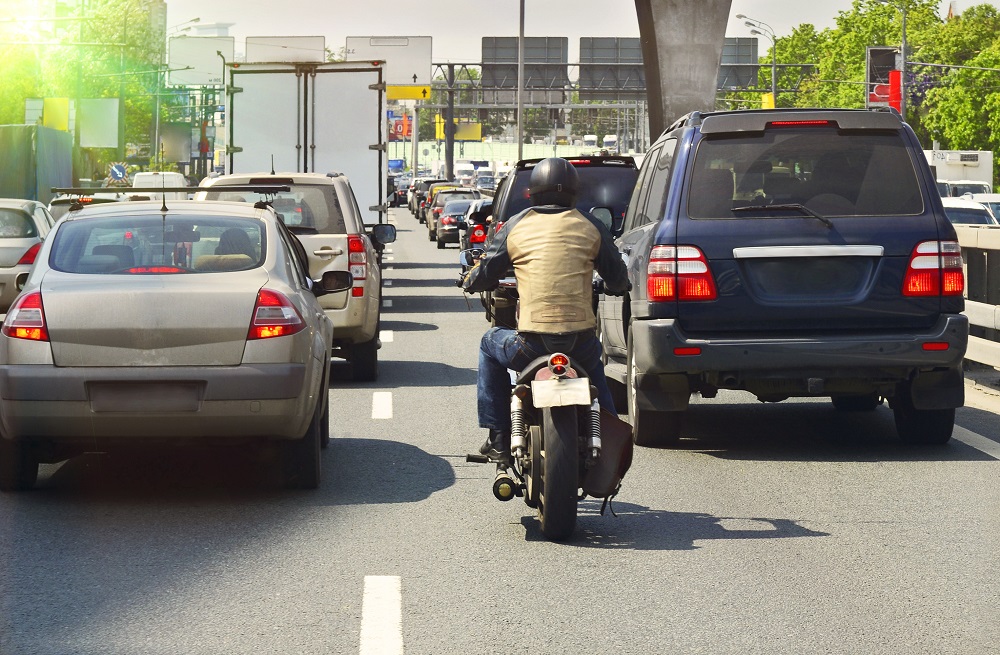
Imagine being stuck in traffic on your motorcycle going down I-35 on a sunny afternoon. You are eager to arrive at your destination, but traffic is gridlocked as far as you can see. You think to yourself, “What if I squeeze through the cars and trucks to escape this mess at the next exit?”
Straying from your lane while on a motorcycle into lanes occupied by other vehicles is commonly referred to as “lane splitting.” This practice is illegal in Texas and can land motorcyclists in trouble. Read on to learn more about lane splitting.
Whether or not lane splitting was involved, if you were injured in a motorcycle accident at no fault of your own, you may be entitled to compensation and should have your case reviewed by an attorney. The Wilhite Law Firm is ready to evaluate and handle your case. Call today for a free consultation.
What Is Lane Splitting?
Again, lane splitting — also known as “white lining” or “stripe riding” — refers to the practice of maneuvering a motorcycle between occupied lanes on the road to move through traffic more quickly. This is possible on motorcycles because they are significantly smaller and narrower than nearly all other vehicles, allowing them to fit in the gaps between slow-moving or fully-stopped automobiles.
Understandably, lane splitting may seem like an attractive alternative to being stuck in traffic for hours. It is particularly attractive in populous urban areas, such as Dallas-Fort Worth, that regularly experience heavy traffic. To save time, motorcyclists may feel tempted to slowly weave their way forward through a traffic jam. Some may even be tempted to try it at higher speeds.
Is Lane Splitting Safe?
On the one hand, the compact size of motorcycles makes lane splitting possible. And who can deny the appeal of moving quickly through traffic while everyone else is stalled on the road? On the other, however, the complete exposure of motorcyclists in the event of an auto accident makes them especially vulnerable to serious injuries.
Ultimately, lane splitting increases the probability that one of these accidents will occur. First, drivers in stopped or slow-moving traffic do not normally expect someone to travel alongside them in the same lane. If the driver does not notice the motorcycle pulling up next to their vehicle, they may open the door and hit the lane-splitting motorcyclist, causing a serious accident.
Second, traffic patterns often change quickly. In one minute, you might be stuck in logjammed traffic. In the next, everyone might have accelerated back to highway speeds. If stuck between larger vehicles — for example, tractor-trailers on a major highway — lane-splitting motorcyclists may find themselves in a dangerous situation.
That said, proponents of lane splitting claim that the practice decreases the likelihood of being rear-ended on a motorcycle. They argue that distracted drivers in stop-and-go traffic situations often do not see motorcyclists in time to avoid collisions. Therefore, in addition to arriving at their destination faster, lane splitting also allows motorcyclists to maneuver their way out of dangerous situations more quickly.
Lane-Splitting Laws
No matter which side of the debate you align with most closely, lane splitting is illegal in Texas. Specifically, the law mandates that all motorists — including motorcyclists — on a “roadway divided into two or more clearly marked lanes for traffic . . . shall drive as nearly as practical entirely within a single lane . . . and may not move from the lane unless that movement can be made safely.”
In fact, lane splitting is illegal in every state except California. That said, there have been efforts in Texas and beyond to legalize the practice.
For example, in 2017, a bill was proposed in the Texas legislature to make the current lane-splitting laws more lenient. Specifically, it would have allowed motorcyclists to operate their vehicles “for a safe distance between lanes of traffic moving in the same direction during periods of traffic congestion.”
Had the law passed, motorcyclists would still have only been allowed to lane split through traffic moving at 20 miles per hour or less. Further, lane splitters would have been limited to traveling at no more than 5 miles per hour faster than the surrounding traffic. Ultimately, the bill was not approved, and the ban on lane splitting remains in place.
Common Lane-Splitting Accident Injuries
Like any auto accident, lane-splitting accidents can result in serious injuries. However, because motorcycles are simply not as crashworthy as larger vehicles and offer riders much less protection, accidents involving these vehicles are often among the most serious we see.
According to the Insurance Information Institute (III), there were 5,579 motorcyclist fatalities in the United States in 2020 alone. Motorcyclists involved in lane-splitting accidents may also suffer:
- Broken and fractured bones
- Cuts and puncture wounds
- Head and brain injuries
- Neck and spine injuries
- Facial and dental injuries
- Burns and road rash
- Internal bleeding and organ damage
- Strains, sprains, and bruises
- Scarring and disfiguration
- Permanent disability
- Psychological trauma
Who Is Liable in a Lane Splitting Accident?
In most personal injury cases, injury victims may recover compensation from anyone whose negligent actions gave rise to their injuries. When arguing negligence, it is necessary to prove that the at-fault party violated their duty to use “reasonable care” to avoid harming other people. However, in cases where a driver did not obey traffic laws, they may be considered negligent per se. That is, they may be held automatically liable for accidents caused by their failure to follow the law.
Since lane splitting is illegal in Texas, this means that lane-splitting motorcyclists may automatically be considered responsible for the injuries they suffer in an accident caused by their violation of the law. If they are found to be fully responsible, they will not be entitled to any compensation.
However, Texas also follows a legal doctrine known as “comparative negligence,” which weighs the responsibility of each driver for an accident and calculates compensation accordingly. In Texas, an injured motorcyclist who is partially at fault for an accident can still seek compensation from other at-fault parties, provided the motorcyclist is not more than 50 percent at fault.
For example, imagine that a lane-splitting motorcyclist sustains $100,000 in injuries. If a Texas jury finds that lane splitting only contributed 30 percent to the accident, the motorcyclist’s compensation is reduced proportionately to $70,000. However, if the jury finds that it contributed 50 percent or more to the accident, the motorcyclist recovers nothing.
Each lane-splitting accident should be evaluated by a personal injury lawyer on a case-by-case basis. Lane splitting may not fully prevent injured motorcyclists from seeking compensation, but it can have an impact on the amount of compensation they are able to recover. The Wilhite Law Firm is ready to review your case and fight for maximum compensation on your behalf.
Contact a Texas Motorcycle Accident Lawyer Today
 Together, the small size of motorcycles relative to other vehicles and the complete exposure of motorcyclists in the event of a collision make motorcycle accidents especially dangerous. Further, because lane splitting is illegal in most of the country, motorcyclists injured while engaged in this practice may face complicated legal obstacles on their path toward compensation.
Together, the small size of motorcycles relative to other vehicles and the complete exposure of motorcyclists in the event of a collision make motorcycle accidents especially dangerous. Further, because lane splitting is illegal in most of the country, motorcyclists injured while engaged in this practice may face complicated legal obstacles on their path toward compensation.
In situations like this, it is essential to have an experienced personal injury attorney handling your case. The Wilhite Law Firm is ready to fight for you. Contact us today for a free consultation.






















